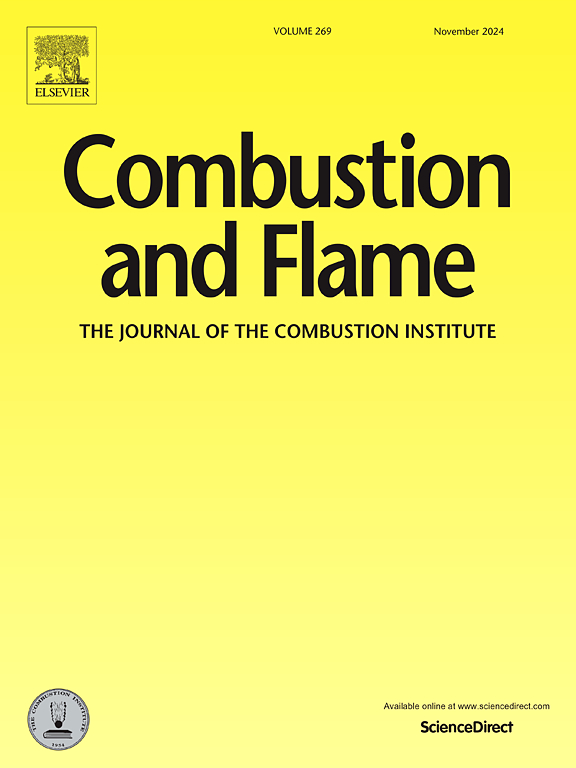Interaction of ammonia with nitric oxide and nitrous oxide: Multi-species time-history measurements and comprehensive kinetic modeling
IF 5.8
2区 工程技术
Q2 ENERGY & FUELS
引用次数: 0
Abstract
Interaction chemistry of ammonia and nitrogen oxides (NOx and N2O) was investigated with the help of laser-based multi-species measurements in a shock tube. Mid-infrared laser diagnostics were set up to measure the time-histories of NH3, NO, N2O and H2O in shock-heated NH3/NO/Ar and NH3/N2O/Ar mixtures over temperatures of 1418–2381 K and pressures of 1.10–1.90 bar. A comprehensive H/N/O nitrogenous combustion model was formulated and validated with our experimental data, as well as a wide array of literature data encompassing various NH3-NOx systems and other nitrogenous systems over temperatures of 425–2455 K, pressures of 0.8–100 bar, and equivalence ratios of 0.23–2.7. In the NH3-NO system, the reactions NH2+NO=N2+H2O and NH2+NO=NNH+OH dominate NH3 consumption and NO reduction, while NH+NO=N2O+H governs N2O formation. Sensitivity analysis of the branching ratio of NH2+NO→NNH+OH and NH2+NO→N2+H2O highlighted the significance of the proposed rate values in improving model performance, particularly at temperatures below 1800 K. In the NH3-N2O system, the kinetics of NH2+N2O, NH+N2O and NH3/NH2/NH+O were identified as critical targets for kinetic modeling. Experimental and kinetic analysis revealed a three-stage NO reduction phenomena in NH3-NO system, with effective NO reduction occurring over a narrow temperature range of 1400–1600 K and residence times ranging 1 to 700 ms. In the NH3-N2O system, nearly 90 % nitrogen oxides reduction was observed over 1075–1600 K and residence times of <1 s. These findings provide valuable insights for optimizing ammonia-fueled combustion systems to minimize nitrogen oxide emissions.
氨与一氧化氮和氧化亚氮的相互作用:多物种时程测量和综合动力学建模
利用激波管内激光多组分测量技术研究了氨和氮氧化物(NOx和N2O)的相互作用化学。建立了中红外激光诊断仪,在温度为1418 ~ 2381 K、压力为1.10 ~ 1.90 bar的条件下,测量了激波加热的NH3/NO/Ar和NH3/N2O/Ar混合物中NH3、NO、N2O和H2O的时程。我们建立了一个全面的H/N/O含氮燃烧模型,并利用我们的实验数据,以及广泛的文献数据,包括各种NH3-NOx系统和其他含氮系统,温度为425-2455 K,压力为0.8-100 bar,当量比为0.23-2.7。在NH3-NO体系中,NH2+NO=N2+H2O和NH2+NO=NNH+OH反应主导着NH3的消耗和NO的还原,而NH+NO=N2O+H控制着N2O的生成。对NH2+NO→NNH+OH和NH2+NO→N2+H2O的支化比的敏感性分析表明,所提出的速率值对提高模型性能具有重要意义,特别是在温度低于1800 K时。在NH3-N2O体系中,NH2+N2O、NH+N2O和NH3/NH2/NH+O的动力学被确定为动力学建模的关键目标。实验和动力学分析表明,NH3-NO体系中存在三个阶段的NO还原现象,在1400 ~ 1600 K的狭窄温度范围和1 ~ 700 ms的停留时间内有效还原NO。在NH3-N2O体系中,1075 ~ 1600k,停留时间为1 s,氮氧化物还原率接近90%。这些发现为优化氨燃料燃烧系统以减少氮氧化物排放提供了有价值的见解。
本文章由计算机程序翻译,如有差异,请以英文原文为准。
求助全文
约1分钟内获得全文
求助全文
来源期刊

Combustion and Flame
工程技术-工程:化工
CiteScore
9.50
自引率
20.50%
发文量
631
审稿时长
3.8 months
期刊介绍:
The mission of the journal is to publish high quality work from experimental, theoretical, and computational investigations on the fundamentals of combustion phenomena and closely allied matters. While submissions in all pertinent areas are welcomed, past and recent focus of the journal has been on:
Development and validation of reaction kinetics, reduction of reaction mechanisms and modeling of combustion systems, including:
Conventional, alternative and surrogate fuels;
Pollutants;
Particulate and aerosol formation and abatement;
Heterogeneous processes.
Experimental, theoretical, and computational studies of laminar and turbulent combustion phenomena, including:
Premixed and non-premixed flames;
Ignition and extinction phenomena;
Flame propagation;
Flame structure;
Instabilities and swirl;
Flame spread;
Multi-phase reactants.
Advances in diagnostic and computational methods in combustion, including:
Measurement and simulation of scalar and vector properties;
Novel techniques;
State-of-the art applications.
Fundamental investigations of combustion technologies and systems, including:
Internal combustion engines;
Gas turbines;
Small- and large-scale stationary combustion and power generation;
Catalytic combustion;
Combustion synthesis;
Combustion under extreme conditions;
New concepts.
 求助内容:
求助内容: 应助结果提醒方式:
应助结果提醒方式:


